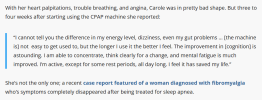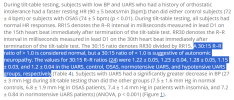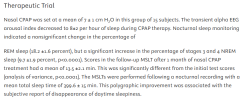nataliezzz
Senior Member (Voting Rights)
It's a disgrace.After visiting 5 different sleep clinics across 3 countries and consulting with multiple specialists at each, I have yet to find a single one that cares about anything other than AHI - no matter what the polysomnogram or OSCAR read-out might say about flow limitations. It is infuriating.
100%. I had a bit of a traumatizing experience myself trying out ASV (I decided to try it since even on BiPAP I was having quite a few central apneas and periods of irregular breathing); the pressure settings were not right the first night I tried it and it ramped the pressure up way too high, blowing air out my mouth. I had a horrible headache, anxiety & dry mouth the next morning. I ended up giving it another try (a couple weeks later cause I was scared to try again) with the lowest pressure settings (it did eliminate the central apneas but still resulted in too many pressure swings for me so I ended up just going back to regular BiPAP)For what it's worth, I would also caution that, while it can be life-saving and life-changing for some, PAP therapy can also be extremely difficult, disruptive, and potentially damaging for some pwME whose "rest" is already near non-existent and for whom a particularly stressful night can lead to a crash. Attempting to titrate CPAP certainly caused me a fair amount of trauma during the years when I thought it might prove the solution for my problems.
You may appreciate what Dr. Barry Krakow has to say on the topic (he is a big proponent of starting people on BiPAP/ASV rather than CPAP):
"This really stupid ignorant approach to 'Oh, take your CPAP machine home with you and use it for a couple of months and come back and talk to us.' That's horrible patient care, and many people get traumatized by it. We learned early on about this phenomenon: If you have someone go through that experience, they will not come back to a sleep lab for at least 1 year, and sometimes 5 years, because they hated what they had to go through that first time. We used to see thousands of CPAP failure cases and switch them over [to BiPAP/ASV] and these people were up in arms like 'Why didn't the doctors give us this device the first time? This is so easy to use, I could have used this 5 years ago. Why wasn't I given that opportunity?' That's still the way sleep medicine is practiced today, which is a big problem, in my opinion."



